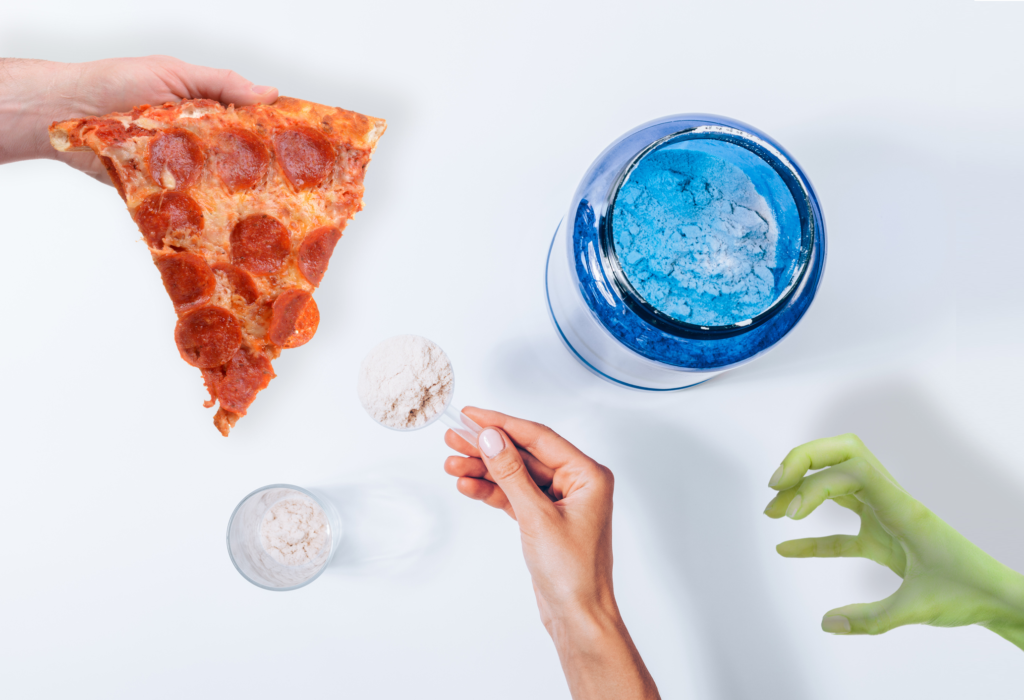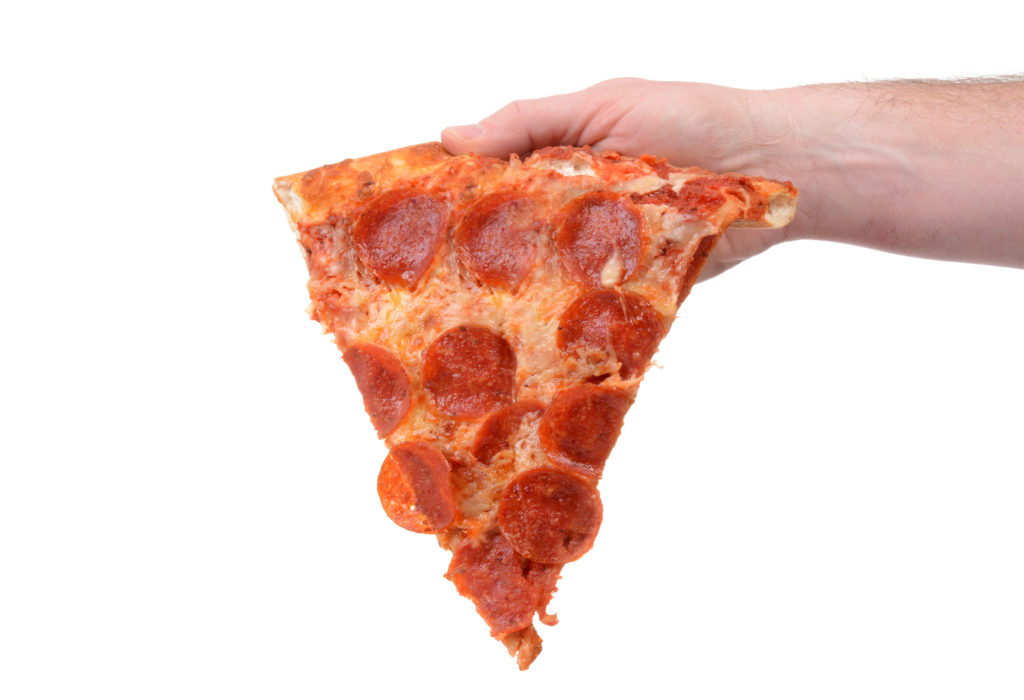Meal Replacements for the Zombie Apocalypse?

Wherever you find yourself parted from your shopping dollars today – be it the homogenized grocery store or the specialist vitamin shop – you will be assured of a veritable feast of foods. And we don’t just mean the healthy, natural, rainbow-hued, compost-flecked items from the organic produce aisle. Scan the shelves of any food outlet and you’re going to be met by a plethora of options for ready-to-drink meal replacers – from those that are integral to weight loss (think SlimFast or Ensure) to others aimed squarely at the fitness crowd building muscle or bio-hacking their bodies through optimal nutrition. And for the past couple of years an oddly familiar name has crept onto the shelves. A product, the very mention of which is calculated to elicit a mock blood-curdling scream: ‘It’s people!!!!’ And now the question is: ‘And is it safe…?’
Soylent, the new cult beverage that’s swept the U. S. and is now gaining traction across The Pond in the U. K., is aimed less at weight watchers and more at those who simply do not have the time, capacity, or perhaps the imagination to prepare chewable meals.
Fans range from overworked corporate drones with 14 hour workdays to gamers reluctant to tear themselves from hypnotizing screens to plug in a toaster oven. According to an article in Beverage Daily, an online news source for the beverage industry, Soylent is targeted at ‘time-strapped consumers [whose] hectic schedule may otherwise cause them to make unhealthy, unsustainable or expensive on-the-go choices.’(1)
Originally debuting in four flavors – strawberry, vanilla, mocha, and bewilderingly ‘neutral’ – Soylent is offered in ready-to-drink single meal bottles with a 12-month shelf life and as tubs of ready-to-mix powder. And the line now rounds out with the new café flavors, Chai and Coffiest, which we had the opportunity to sample at the Worlds Fair Nano 2018 in San Francisco last March. And they were really not bad at all. Although the erstwhile ‘neutral’ – now ‘Original’ – option is largely devoid of flavor of any kind, we have to admit that the strawberry, chai, and coffiest certainly did hit the spot. So what is this oddly-named beverage and why is it suddenly so popular?
According to an article in the Canadian Broadcast Corporation’s website to which we will return later, Soylent ‘is sold less as a drink and more as a lifestyle.’(2) The relatively young company was started via a small grant from a start up incubator in the San Francisco Bay Area and generated a $3 million nest-egg when Founder and CEO Rob Rhinehart, an electrical engineering and computer science graduate, completed a successful crowd-funding campaign.
Leveraging the ghostly echoes of Harry Harrison’s science-fiction that initially inspired Soylent Green, the iconic movie which naturally springs to mind, Rhinehart saw the challenge of feeding a growing population as inherently a food engineering problem. And he addressed it by deconstructing the concept of balanced nutrition into its composite elements and building a meal substitute that would offer complete nutrition on a ‘molecular level.’(3) And although he admits – with a disarming degree of honesty – that Soylent ‘may not be the most pleasurable meal in the galaxy’ it is nonetheless ‘very functional,’ and achieves its goal of improving the food system.(4)
And Rhinehart freely acknowledges that his product, and those like it, are simply the next iteration of functional foods – a trend that began decades ago with iodized salt, fortified cereals and milks that aimed to balance the nutritional deficiencies that were then ‘just part of life.’(5) And in this vein, he has taken steps which are somewhat common in the computer programming arena – his erstwhile milieu – but highly unusual in the food and beverage industry: he has made his product ‘open source.’ The broader community that sprang up around Soylent quickly created DIYSoylent (now re-named Complete Foods), an online recipe formulator that allows anyone with an interest in functional foods to create their own take on the product. And this is how Zoylent (available in Asia), Schmoylent (now Schmilk), and Joylent (now rebranded as ‘Jimmy Joy’) came into existence. Confused by all of these ‘-lents’? So were we, so to save our (clearly malnourished) brains we opted to focus mainly on the original, Soylent.
‘Is this the future of food?
Interestingly, so did astrophysicist, science communicator, and self-confessed steak-lover Neil DeGrasse Tyson. In his interview with Rhinehart for Tech Insider he asked ‘Is this the future of food? Or is this something to get us thinking [in] new ways about food?’ And the answer is…both. Not only is Soylent a solution to a specific problem – food being an inefficient means of taking in nutrients – but it is also a reflection on the process of production. In considering the issue from an engineering perspective, Rhinehart understood that the body needs ‘amino acids and lipids, not milk itself. […] carbohydrates, not bread [and that] fruits and vegetables provide essential vitamins and minerals but they’re mostly water.’(6) So the process of engineering and manufacturing Soylent takes the wider view on food, lending a new focus to the vertical integration of its production and emphasizing the importance of producing the maximum number of calories per solar unit of energy.
In other words, Rhinehart recognized the inherent wastefulness of a process that relies upon calories derived from meat and dairy in our diet. In eating animal products, we consume the flesh of creatures who derived their energy from plants. In turn, those plants drew their energy from the sun. And, if we follow the logic of this chain, we see that, in effect, all of our calories come from the sun. Suppose, Rhinehart suggests, we cut out the middle man – or, in this case, middle animal – and go to the source: getting our calories through animals products means we lose a lot of energy along the way and ‘the more directly you can extract that energy from the sun, the better.’(7) Better potentially for us, better for the planet, and certainly better for the animals.
But that’s not to say that everyone is embracing this new development. Let’s return to that CBC article we mentioned above…
According to press north of the border, the Canadian Food Inspection Agency (CFIA) adjudicated that Soylent does not meet ‘the compositional requirements for meal replacement products,’ halting imports until the deficiencies are rectified.
In response, in an open letter to Canadian customers, Rhinehart emphasized that, while the company will take measures to comply with the regulatory body’s demands, it ‘feel[s] strongly that these requirements do not reflect the current understanding of human nutritional needs.’(8) But it might behoove Rhinehart to make the necessary changes as soon as possible given that Biolent, a Canadian version of Soylent, is snapping at his heels in the North. With meals coming in at around $3 per serving (a lower price point than Soylent), Biolent is available as a powder form to which the customer simply adds water. With ‘every essential vitamin and mineral as well as superfoods and added probiotics,’ Biolent claims to offer the perfect balance of carbs (from oats and buckwheat), fats (coconuts, flax seeds, and sunflower seeds), and protein (brown rice and pea protein).(9) The added superfoods are ingredients such as the always popular spirulina, nutty little chia seeds, and the perennially dismaying kale.
But those of us who like to chew on the nuts and bolts data of food safety protocols such as cGMP or HACCP will go hungry.
With all of that said, amid the simmering soup of ingredient data and optimal nutrition claims, there is a woeful lack of solid product safety information into which to sink our metaphorical teeth. Soylent’s website offers the best information insofar as it does list the drinks, powders and newly the bar as generally recognized as safe (GRAS) and as being produced in a GMP-certified facility. Which, in comparative terms, is outstanding. Manufacturers of the other ‘-lents’ are quick to offer glamor shots of athletes in training, their exquisitely sculpted bodies in states of perpetual motion, alongside exhortations to ‘save time’ or ‘do more,’ for consumers to salivate over. But those of us who like to chew on the nuts and bolts data of food safety protocols such as cGMP or HACCP will go hungry.
Of course, given that there are no active recalls or warnings, we have to assume that the products are safe and have passed the scrutiny of the Food and Drug Administration (FDA). But when a product is designed specifically to replace not only a food but the concept of food in its entirety – carbs, fats, and proteins, essential vitamins and minerals, amino acids, and indeed everything but the hydration – it is perhaps not too much to hope that its safety is something that we all take seriously. And taking it seriously entails documenting your processes, protocols, controls, supply chain analyses, and distribution regulation at least as prominently as the six-pack abs of the 25-year old ultra-runner gracing your website.
So, given that few of us here at Berkshire are as chiseled and ripped as those lean, toned burpee-addicted models on the corporate websites chugging down their Soylent/Joylent.Zoylent/Biolent, forgive us if we decide, for the moment at least, to stick to foods that – while perhaps nutritionally imbalanced – allow us the joy of mastication. Another slice of pizza anyone…?

Is the future of nutrition the meal replacement drink? Could you ever give up food in favor of just downing a beverage, however perfect its nutritional balance? We’d love to know your thoughts!
Update:
Soylent, Joylent, Zoylent, and Biolent
References:
- https://www.beveragedaily.com/Article/2018/09/17/Soylent-cult-following-in-the-US-leads-to-UK-launch
- https://www.cbc.ca/news/health/soylent-no-longer-to-be-sold-in-canada-1.4371535
- https://www.youtube.com/watch?v=U-8lPrWzyY8
- ibid
- ibid
- https://www.newyorker.com/magazine/2014/05/12/the-end-of-food
- https://www.youtube.com/watch?v=U-8lPrWzyY8
- https://faq.soylent.com/hc/en-us/articles/115005267426
- https://biolent.ca/

Pingback: Duckweed - Food Contact Surfaces
Pingback: Update: Soylent, Joylent, Zoylent, and Biolent - Food Contact Surfaces